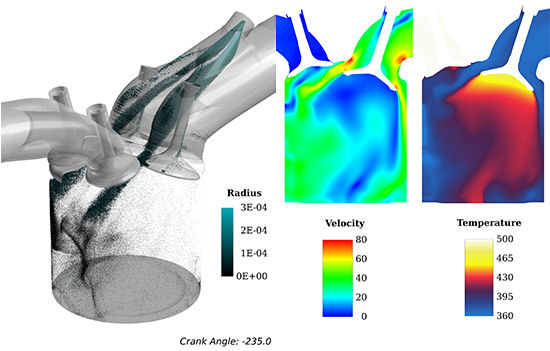Simulation Interactively Explores Internal Combustion Engine
Latest News
October 31, 2014
 Dear Desktop Engineering Reader:
Dear Desktop Engineering Reader:
Engineers will use every bit and byte of computing horsepower to improve their CFD (computational fluid dynamics) simulation accuracy through finer and finer meshes and with more and more particles. There’s a cost for this. For example, using CFD for internal combustion engine (ICE) analysis means extremely long transient runs to reach convergence and huge amounts of data that requires a lot of review time. Today’s Check it Out link takes you to an on-demand webinar that argues you can get more out of your CFD simulations and results post-processing than you probably get now by using traditional methods.
The “Interactive Exploration of High Fidelity ICE Simulations” on-demand webinar is a joint presentation of Intelligent Light and Convergent Science, the developers of the FieldView CFD post-processor and CONVERGE CFD software, respectively. The goal of the presentation is to demonstrate how you can create and analyze ICE simulations with hundreds of time steps and hundreds of thousands of simulated particles, then interactively explore your high-fidelity data to improve understanding of your results. It’s a highly intriguing presentation loaded with data and animations.
Two things about CONVERGE. One is that Convergent Science has chops in the engine design analysis field. The company also has a growing footprint in such areas as gas turbines, pumps and compressors and applications with fluid structure interactions and conjugate heat transfer challenges.
Two, CONVERGE uses a fully coupled automated meshing process with Adaptive Mesh Refinement (AMR) that decreases time spent generating a mesh, which can save you a lot of time. This is the heart of Convergent’s part of the demo. The key to this technology is that you do not feed it a grid directly. Rather, you feed it your geometry and details on boundary conditions, motions and so forth from which CONVERGE creates and refines the grid at run-time. For simulations with moving boundaries, the grid is recreated at each time step.
The presentation begins with setting up CONVERGE for the ICE case study simulation. Topics covered include spray modeling, turbulence modeling and line plotting. There are some particularly neat animations of the intake valves, exhaust valves and pistons moving at about the 7:40 mark. Later, at the 18:20 mark, you get some close-up animations showing meshing with AMR techniques.
FieldView then takes over at about the 23-minute mark. The basic question explored here is what do you do with all that data so that you can make better sense of it?
FieldView, which is mesher and solver independent, provides post-processing tools to display and animate your data quickly as well as interactively explore the data. In this demo, the ICE simulation generated terabytes of data from a single simulation run. Data was derived from five engine cycles, processing of every 2 degrees of crank angle (some 1000 process steps), dozens of reacting species as well as mixing and combustion modeling of a million particles.
The FieldView workflow is for dealing with volumes of data, creating objects and visualizing results. In simplified terms, the FieldView approach breaks down large chunks of data into smaller, more manageable files that you can animate. For the end user running this ICE simulation, the upshot of the process is that you do not need to re-run the solver to generate a new animation. In this demo, creating a new animation with all the time steps took about 90 minutes instead of days.
The “Interactive Exploration of High Fidelity ICE Simulations” webinar runs just over 43 minutes, and there is just a ton of stuff going on in it. Your takeaway from this presentation is that CONVERGE can simulate hundreds of thousands of particles easily and that FieldView can visualize them. And it can all happen in less time that you imagine. Fascinating stuff. Hit today’s Check it Out link to see it for yourself.
Thanks, Pal. – Lockwood
Anthony J. Lockwood
Editor at Large, Desktop Engineering
Subscribe to our FREE magazine, FREE email newsletters or both!
Latest News
About the Author
Anthony J. Lockwood is Digital Engineering’s founding editor. He is now retired. Contact him via [email protected].
Follow DE






